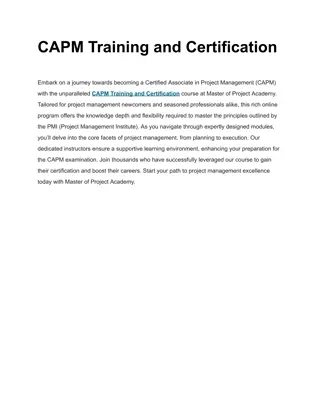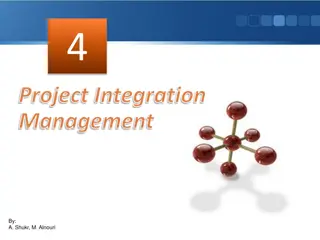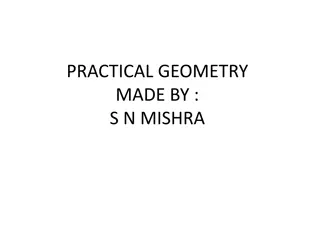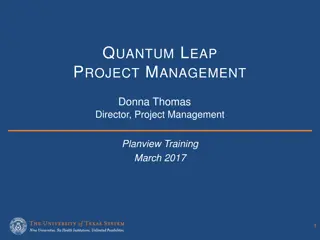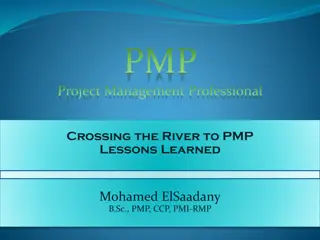Practical Guide to Project Management for HR Professionals
This practical introduction explores scheduling, resources, and budgets in strategic project management for HR professionals. Learn about work breakdown structures, deliverables vs. work packages, budgeting concepts, and the benefits of contingencies. Discover how to optimize resources and balance constraints for project success.
Download Presentation

Please find below an Image/Link to download the presentation.
The content on the website is provided AS IS for your information and personal use only. It may not be sold, licensed, or shared on other websites without obtaining consent from the author.If you encounter any issues during the download, it is possible that the publisher has removed the file from their server.
You are allowed to download the files provided on this website for personal or commercial use, subject to the condition that they are used lawfully. All files are the property of their respective owners.
The content on the website is provided AS IS for your information and personal use only. It may not be sold, licensed, or shared on other websites without obtaining consent from the author.
E N D
Presentation Transcript
Donna Dean, SPT 2013 DPT Capstone Project University of North Carolina at Chapel Hill
Develop a clear understanding of the definition for different etiologies of PFPS. Evaluate a patient with PFPS in an organized and efficient approach. Review special tests and outcome measures that are evidence-based for this population. Understand evidence-based interventions for different etiologies.
Anterior knee pain Runner s knee Subset: Chondromalacia patellae
Unknown etiology Suggested theories: Abnormal patellar tracking and/or malalignment Abnormal soft tissue forces Muscle dysfunction Increased Q angle Tight hamstrings, ITB, quadriceps femoris, and/or gastrocnemius Abnormal tibial and femoral rotation Excessive foot pronation
One of the most frequent complaints in the outpatient setting - both athletic and nonathletic populations affected Affects 25% of the general nonathletic population (Johnston & Gross, 2004; Whittingham et al., 2004) Occurs in all age groups, although most common in adolescents and young adults (Johnston & Gross, 2004) More common in females than males (Dolak et al., 2011; Earl & Hoch, 2011)
Insidious onset of anterior or retropatellar pain associated with: Ascending/descending stairs Prolonged sitting Prolonged walking Squatting Running Hopping/jumping Palpation of patellar facets Compression of patella
PFPS is often considered a diagnosis of exclusion after ruling out competing diagnoses(Cook, 2010) Strongest combination of tests, LR+ of 4.0* - 2 of the 3 positive findings for pain during: resisted quadriceps muscle contraction and/or squatting and/or palpation of patellar facets resisted quadriceps muscle contraction squatting palpation of patellar facets (Cook, 2010) *This is only after ruling out other possibilities
Meniscal injury Joint line tenderness ACL injury PCL injury MCL and LCL instability stress tests Medial plica syndrome test Meniscal injury Apley s compression test, ACL injury Lachman s test PCL injury Posterior drawer test MCL and LCL instability Valgus and Varus Medial plica syndrome Mediopatellar plica
Apleys Compression Test + knee pain, clicking
Joint line tenderness + pain with palpation
Lachmans test knee flexed 20-30 + excessive anterior translation of the tibia on the femur with an absent/diminished end point
Posterior drawer test + excessive posterior translation of the tibia on the femur
Valgus and Varus stress tests at 0 and 30 knee flexion + excessive movement, pain
Mediopatellar plica test Kim et al., 2007 + tenderness with manual force in extension, pain diminished at 90 flexion
Strength Flexibility Patellar malalignments Foot mechanics Strength Flexibility Patellar malalignments Foot mechanics
Determine what is weak MMT: Quadriceps Hip external rotators Hip abductors Gluteal muscles
VL is often found to fire prior to the VMO in pts with PFPS during functional tasks (Boling et al., 2006, Cowan et al., 2002) This may lead to lateral tracking of the patella by action of the VL (Akbas et al., 2010) Pts with unilateral PFPS had bilaterally lower VMO:VL ratios (Souza & Gross, 1991) In pts with PFPS, the VMO+VML contributed significantly less to the knee extension torque than the VL (Makhsous et al., 2004) Can PT make a difference in the VMO:VL ratio?
A comprehensive PT program incorporating VMO retraining with biofeedback resulted in improved VMO:VL timing (Cowan et al., 2002) What if you do not have access to a biofeedback system? USE THE EVIDENCE!
Isotonic quadriceps contractions produce larger VMO:VL activity compared to isometric contractions (Souza & Gross, 1991) A WB rehabilitation program (with no focus on specific VMO activation) integrating balance, stretching, and strengthening exercises normalized the onset of the VMO relative to the VL, decreased pain, and increased function (Boling et al., 2006)
Chicken or the egg? It is unknown whether hip weakness causes or is the result of PFPS (Bolgla et al, 2008) Isolated hip abductor and external rotator muscle strengthening decreases pain (Earl & Hoch, 2011; Dolak et al., 2011) and improves function in females with PFPS including long-term benefits (Khayambashi et al., 2012) A hip-strengthening program may decrease prevalence and recurrence of PFPS in sedentary women (Fukuda et al., 2012)
Include hip abduction and hip external rotation exercises Include hip extension exercises if this area is weak as well Focus on proper form and alignment See the Assessment Tool for therapeutic exercises!
Both WB and NWB exercises decrease pain and increase muscle strength and function in males 18-35yo with PFPS (Herrington & Al-sherhi, 2007) NWB exercises help isolate and strengthen hip musculature prior to WB exercises and functional training for patients with PFPS (Mascal et al., 2003)
TFL/ITB Ober s Test Hamstrings 90/90 Test Quadriceps Modified Thomas Test Gastrocnemius Patient prone with feet hanging off plinth and leg extended, firmly push into DF to test for tightness Gross, 1995
Warm up soft tissue structure ITB stretch Sidelying or Standing Hamstring stretch Supine or Seated Quadriceps stretch Supine or Standing Gastrocnemius stretch Standing
Glide Rotation Tilt
With the patient in supine, look for glide, tilt, and rotation of the patella Assess for patella alta with the patient sitting and knees in 90 flexion
Medial glide: if patella is displaced <1 quadrant = tight lateral structures >3 quadrants = hypermobility
Elevate lateral aspect of patella to test for tight lateral structures
The patella may appear properly aligned statically, but then deviate during terminal extension
McConnell technique Restricted medial glide from lateral border of patella and pull just past medial femoral condyle L Lateral tilt patella to medial femoral condyle to lift lateral border and stretch tight structures Lateral (external) rotation of inferior pole pole upward and medially Restricted medial glide: correct by placing tape ateral tilt: correct by placing tape from midline of Lateral (external) rotation of inferior pole: tape from the middle inferior
Kinesio Taping Method designed to facilitate the body s natural healing process while allowing support and stability to muscles and joints without restricting the body s range of motion. (www.kinesiotaping.com) Elastic and latex-free, can be worn 3-7 days before changing Addition of kinesio taping to a conventional exercise program does not improve outcomes in patients with PFPS (Akbas et al., 2011)
(Akbas et al.,2011)
It It remains unclear remains unclear! ! It also unknown whether patellar taping facilitates (Whittingham et al., 2004) or decreases (Ng & Cheng, 2002) VMO activity
McConnell method combined with exercises had greater improvement in pain and function than placebo taping + exercises or exercises alone (Whittingham et al., 2004) Immediate decrease in pain in patients with PFPS, regardless of how it was applied - medial, neutral, or lateral (Wilson et al., 2003) Many studies suggest taping provides pain relief, but there is much controversy on how this is achieved! Many studies suggest taping provides pain relief, but there is much controversy on how this is achieved!
Patellofemoral malalignment has been associated with excessive subtalar joint pronation during stance phase of gait (Saxena & Haddad, 2003) Excessive foot pronation defined as: >9 calcaneal valgus for rearfoot angle <141 longitudinal arch angle in bilateral WB (Johnston & Gross, 2004) Rearfoot eversion Related to tibial internal rotation and hip adduction (Barton et al., 2012)
Rearfoot angle the acute angle between the midlines of the calcaneus and distal leg in bilateral WB Longitudinal arch angle navicular tubercle as axis, obtuse angle from medial malleolus to first metatarsal head (Johnston & Gross, 2004) (Johnston & Gross, 2004)
Orthotics Purpose is to limit excessive foot pronation, thus reducing excessive tibial and femoral internal rotation that leads to lateral patellar displacement (Johnston & Gross, 2004) 3 major driving forces of pronation: tibial varum, forefoot varus, and tight triceps surae (Gross, 1995) Orthotic should include: Support for the concavity of the medial longitudinal arch Medial rearfoot post when tibial varum is present Medial forefoot post when forefoot varus is present (Johnston & Gross, 2004)
Custom-fit foot orthotics improve pain and stiffness after 2 weeks and physical function after 3 months (Johnston & Gross, 2004) Soft orthotics with medial forefoot and rearfoot rubber wedges combined with an exercise program showed significantly greater reduction in pain than exercise alone (Eng & Pierrynowski, 1993)
Semicurved- or straight-shaped last Combination or board last Firm midsole density Firm stiffness of the heel counter No heel flare Firm stiffness of the rearfoot portion (Johnston & Gross, 2004)
Increasing VMO activation and normalizing VMO/VL ratio Strengthening hip abductors and external rotators Patellar taping Foot orthotics Topics and interventions not covered: lumbopelvic manipulation, patellar bracing, thoracic ring shift, failed load transfer in the pelvis, surgical interventions
A 6wk program of PT interventions showed beneficial results for pain and function significantly greater than a placebo regimen (Crossley et al., 2002) Arthroscopy included with an HEP had no advantages over the HEP alone (Kettunen et al., 2007)
Determine all driving forces behind the pain PFPS is likely the result of a dynamic dysfunction of the interaction between the lumbopelvic region, hip, knee, and foot (Lowry, 2008) Modify activities Are activities adding fuel to the fire? Determine appropriate progression for magnitude, frequency and duration of exercises Pay attention to proper alignment and normal tracking during all activities!
Visual Analog Scale or Numeric Pain Rating Scale Anterior Knee Pain Scale Also known as the Kujala Scale Lower Extremity Functional Scale
Dolak KL, Silkman C, McKean JM, Hosey RG, Lattermann C, Uhl TL. Hip strengthening prior to functional exercises reduces pain sooner than quadriceps strengthening in females with patellofemoral pain syndrome: a randomized clinical trial. J Orthop Sports Phys Ther. 2011 June;41(8):560-570. Earl JE, Hoch AZ. A proximal strengthening program improves pain, function, and biomechanics in women with patellofemoral pain syndrome. Am J Sports Med. 2011 Jan;39(1):154-63. Fukuda TY, Melo WP, Zaffalon BM, Rossetto FM, Magalhaes E, Bryk FF, Martin RL. Hip posterolateral musculature strengthening in sedentary women with patellofemoral pain syndrome: a randomized controlled clinical trial with a 1-year follow-up. J Orthop Sports Phys Ther. 2012;42(10):823-30. Song C, Lin Y, Wei T, Lin D, Yen T, Jan M. Surplus value of hip adduction in leg-press exercise in patients with patellofemoral pain syndrome: a randomized controlled trial. Phys Ther. 2009 May;89(5):409-18. Chiu JKW, Wong YM, Yung PSH, Ng GYF. The effects of quadriceps strengthening on pain, function, and patellofemoral joint contact area in persons with patellofemoral pain. Am J Phys Med Rehab. 2012 February;91(2):98-106. Bolgla LA, Malone TR, Umberger BR, Uhl TL. Hip strength and hip and knee kinematics during stair descent in females with and without patellofemoral pain syndrome. J Orthop Sports Phys Ther. 2008 January;38(1):12-18. Khayambashi K, Mohammadkhani Z, Ghaznavi K, Lyle MA, Powers CM. The effects of isolated hip abductor and external rotator muscle strengthening on pain, health status, and hip strength in females with patellofemoral pain: a randomized controlled trial. J Orthop Sports Phys Ther. 2012 Jan;42(1):22- 29. Boling MC, Bolgia LA, Mattacola CG, Uhl TL, Hosey RG. Outcomes of a weight-bearing rehabilitation program for patients diagnosed with patellofemoral pain syndrome. Archives of Phys Med and Rehabil. 2006 November;87(11):1428-1435. Roush JR, Curtis Bay R. Prevalence of anterior knee pain in 18-35 year-old females. Int J Sports Phys Ther. 2012 Aug;7(4):396-401.
Whittingham M, Palmer S, Macmillan F. Effects of taping on pain and function in patellofemoral pain syndrome: a randomized control trial. J Orthop Sports Phys Ther. 2004 Sep;34(9):504-10. Wilson T, Carter N, Thomas G. A multicenter, single-masked study of medial, neutral, and lateral patellar taping in individuals with patellofemoral pain syndrome. J Orthop Sports Phys Ther. 2003 Aug;33(8):437-43. Paoloni M, Fratocchi G, Mangone M, Murgia M, Santilli V, Cacchio A. Long-term efficacy of a short period of taping followed by an exercise program in a cohort of patients with patellofemoral pain syndrome. Clin Rheumatol. 2012 Mar;31(3):535-9. Epub 2011 Nov 3. Ng GY, Cheng JM. The effects of patellar taping on pain and neuromuscular performance in subjects with patellofemoral pain syndrome. Clin Rehabil. 2002 Dec;16(8):821-7. Johnston LB, Gross MT. Effects of foot orthoses on quality of life for individuals with patellofemoral pain syndrome. J Orthop Sports Phys Ther. 2004 Aug;34(8):440-8. Barton CJ, Levinger P, Crossley KM, Webster KE, Menz HB. The relationship between rearfoot, tibial, and hip kinematics in individuals with patellofemoral pain syndrome. Clinical Biomechanics. 2012 Aug;27(7):702-5. Eng JJ, Pierrynowski MR. Evaluation of soft foot orthotics in the treatment of patellofemoral pain syndrome. Phys Ther. 1993 Feb;73(2):62-8. Lowry CD, Cleland JA, Dyke K. Management of patients with patellofemoral pain syndrome using a multimodal approach: a case series. J Orthop Sports Phys Ther. 2008 Nov;38(11):691-702. Yosmaoglu HB, Kaya D, Guney H, Nyland J, Baltaci G, Yuksel I, Doral MN. Is there a relationship between tracking ability, joint position sense, and functional level in patellofemoral pain syndrome? Knee Surg Sports Traumatol Arthrosc. 2013 Jan 30. [Epub ahead of print]. Kettunen JA, Harilainen A, Sandelin J, Schlenzka D,Hietaniemi K, Seitsalo S, Malmivaara A, Kujala UM. Knee arthroscopy and exercise versus exercise only for chronic patellofemoral pain syndrome: a randomized controlled trial. BMC Medicine. 2007 Dec 13;5:38. Piva SR, Fitzgerald GK, Wisniewski S, Delitto A. Predictors of pain and function outcome after rehabilitation in patients with patellofemoral pain syndrome. J Rehabil Med. 2009 Jul;41(8):604-12.
Cook C, Hegedus E, Hawkins R, Scovell F, Wyland D. Diagnostic accuracy and association to disability of clinical test findings associated with patellofemoral pain syndrome. Physiother Can. 2010 Winter;62(1):17-24. Souza DR, Gross MT. Comparison of vastus medialis obliquus:vastus lateralis muscle integrated electromyographic ratios between healthy subjects and patients with patellofemoral pain. Phys Ther. 1991 Apr;71(4):310-6. Herrington L, Al-Sherhi A. A controlled trial of weight-bearing versus non-weight-bearing exercises for patellofemoral pain. J Orthop Sports Phys Ther. 2007 Apr;37(4):155-60. Cowan SM, Bennell KL, Crossley KM, Hodges PW, McConnell J. Physical therapy alters recruitment of the vasti in patellofemoral pain syndrome. Med Sci Sports Exerc. 2002 Dec;34(12):1879-85. Akbas E, Atay AO, Yuksel I. The effects of additional kinesio taping over exercise in the treatment of patellofemoral pain syndrome. Acta Orthop Traumatol Turc. 2011;45(5):335-41. Makhsous M, Lin F, Koh JL, Nuber GW, Zhang LQ. In vivo and noninvasive load sharing among the vasti in patellar malalignment. Med Sci Sports Exerc. 2004 Oct;36(10):1768-75. Gross MT. Lower quarter screening for skeletal malalignment suggestions for orthotics and shoewear. J Orthop Sports Phys Ther. 1995 Jun;21(6):389-405. Kim SJ, Lee DH, Kim TE. The relationship between the MPP test and arthroscopically found medial patellar plica pathology. Arthroscopy. 2007 Dec;23(12):1303-8. Mascal CL, Landel R, Power C. Management of patellofemoral pain targeting hip, pelvis, and trunk muscle function: 2 case reports. J Orthop Sports Phys Ther. 2003 Nov;33(11):647-60. Saxena A, Haddad J. The effect of foot orthoses on patellofemoral pain syndrome. J Am Podiatr Med Assoc. 2003 Jul-Aug;93(4):264-71. Crossley K, Bennell K, Green S, Cowan S, McConnell J. Physical therapy for patellofemoral pain: a randomized, double-blinded, placebo-controlled trial. Am J Sports Med. 2002 Nov-Dec;30(6):857-65. Magee DJ. Orthopedic Physical Assessment. 5thed. St. Louis, MO: Saunders Elsevier, Inc; 2008:727- 843.
Pictures: Accessed Jan-April 2013 http://www.aafp.org/afp/2007/0115/p194.html (slide 3, 28, 29, 30) http://www.eorthopod.com/content/chondromalacia-patella (slide 3) http://www.eorthopod.com/content/patellofemoral-problems (slide 3, 26) http://exercisesforinjuries.com/runners-knee-exercise-program/ (slide 4) http://www.aafp.org/afp/1999/1101/p2012.html (slide 5) http://www.4shared.com/photo/PYnAzSn-/apleys_compression_test.html (slide 10) http://meded.ucsd.edu/clinicalmed/joints.htm (slide 11) http://www.aafp.org/afp/2003/0901/p907.html (slide 12, 14) http://www.genu-centrum.com/knee-testing/2/ (slide 13) http://quizlet.com/11882888/knee-ocs-flash-cards/ (slide 15) http://www.proprofs.com/flashcards/cardshowall.php?title=english-4-sat-vocabulary-words-lesson-2 (slide 17) http://running.competitor.com/2012/10/injury-prevention/beating-runners-knee_143 (slide 16) http://rightfitchicago.com/blog/wp-content/uploads/2012/08/590img.png (slide 22) http://beginnerballerina.blogspot.com/ (slide 24) http://www.myprecisionfit.com/test/resultStretching?testResultId=2ebdbf51-6d27-4cd0-ad32-87c05957a89b (slide 25) http://ajs.sagepub.com/content/34/5/749/F3.expansion (slide 27) http://www.beantownphysio.com/pt-tip/archive/mcconnell-taping.html (slide 31) http://www.englishexercises.org/makeagame/my_documents/my_pictures/2011/oct/958_question_clipart.gif (slide 34) http://www.brooksrunning.com (slide 40) http://backandneck.about.com/od/paincharts/ig/Visual-Assessment-Tools/Visual-Analog-Scale-VAS.htm (slide 44) http://thebeeskneesaquiltingbee.blogspot.com/2012_05_01_archive.html (slide 50)
Mike Gross, PT, PhD Lori Von Alten, PT, LAT, ATC, CPI Mary Draize, PT Mike Lewek, PT, PhD


